Continuing our series on the tablet placed in honor of Albany’s charter bicentennial in 1886, we come to a marker that was intended to celebrate George Washington’s visit to the city. From its placement, it seems to have survived until about 1969, but after that its whereabouts are unknown.
Tablet No. 19 – Washington’s Visit.
Bronze tablet, 16 x 22 inches, inserted in Beaver street wall of building north-west corner of Beaver and Green streets. Inscription:
“Site of Hugh Denniston’s Tavern. The First Stone House in Albany, Where Gen. Washington was Presented with the Freedom of the City in 1782 and 1783. It was removed During the Year of the First Cholera, 1832.”
Washington’s visit
An article in the Albany Argus on Feb. 17, 1918, recounted the visit to Albany by George Washington. Given that the United States was then deep into The Great War, The Argus noted that Washington’s birthday was about to be celebrated for the 180th time in Albany, “and now that the great principles of democracy for which the Father of His Country fought are assailed by autocracy and are being defended by the people who are enjoying the fruits of his victory, it is interesting to find that he was no stranger to Albany and that one of her most illustrious songs, General Peter Schuyler, was his intimate friend.”
The article went on to note that in January 1800, just months after the horrific passing of Washington, the Legislature set aside his birthday, Feb. 22, to be “observed in a religious manner. Revs. Eliphalet Nott, Johnson, Ellison and Barrett were chosen chaplains for the session. . . . ” There was also a special sermon in St. Mary’s church that morning, followed by a procession from City Hall, “composed of the executive and judicial officers of the State, both houses of the Legislature, the corporation and citizens, and proceeded through State and Pearl streets to the North church, in which Rev. John B. Johnson eloquently discoursed upon the life and character of Washington.”
The Argus reported that Washington’s first visit to Albany was June 17, 1782, when the bells of all churches were rung, and a 13-gun salute fired at the fort. [Here they’re speaking of Fort Frederick, which stood up State Street near Eagle.] Washington returned a mere four months later, “having little to do in camp at Newburgh until the arrival of the definite treaty, resolved to employ the interval in making a tour to the northward for the double purpose of gratifying his curiosity in visiting the scenes of the late military operations in that quarter and of ascertaining from observation the natural resources of the country. In company with Governor Clinton he ascended the Hudson to Albany and after his reception here proceeded over the battlefields of Saratoga as far as Ticonderoga and Crown Point. Turning then to the Mohawk river, he extended his journey westward to Fort Schuyler. He was absent from Newburgh 19 days.”
The Argus says that on Washington’s first visit (through a typo, they actually wrote 1773), “after the banquet at Denniston’s tavern Washington attended a brilliant reception at Schuyler’s house and on a second visit the following year he slept at the house. It was reported (in 1886) that while at Denniston’s, on July 19, 1783, Washington said, “While I contemplate with irrepressible pleasure the future tranquility and glory of our common country, I cannot but take a peculiar interest in the anticipation of the increase in prosperity and greatness of this ancient and respectable city of Albany, from whose citizens I have received such distinguished tokens of their approbation and affection.”
Several articles repeat the claim that Denniston’s tavern was the first stone building in Albany, without giving a date or saying who built it. Of Denniston himself, we find very little information. A 1903 Argus “Historical Notes by Jed” article celebrating noted Irishmen of the city says that Denniston kept “Albany’s only first-class hotel and tavern for many years . . . A true Irishman, Denniston was an ardent patriot during the war and his hotel was a meeting place for the loyal citizens of Albany, where treason was hatched against England. On both of his visits to Albany in 1782 and in 1783, Washington was a guest at the hotel where he was presented with the freedom of the city. Denniston owned much property in Albany and was a citizen well liked by all. His descendants in the male line are not now known in Albany.” Further basis for any of these claims about Denniston is also not known; most sources just repeat the same details about him, using exactly the same words. We did find a reference in the minutes of the Committee of Correspondence that Denniston had bought a slave at auction in 1777 (and was complaining that she was crazy). We also found reference to his being a Mason with Union Lodge No. 1.
It is only through his will, dated 1785 and printed in something called the John Watts de Peyster Publication Series, that we know that Denniston had at least eight children.
Cholera Comes to Albany
According to Howell’s Bi-centennial History of the City of Albany, cholera made its first appearance on the continent in Quebec in 1832, “and a fortnight later broke out in Albany.” That was coincident with what History.com relates as the second cholera pandemic, the first having begun in 1817 in India and spreading beyond Asia over a six-year period, reaching into Turkey, Syria and southern Russia. It died out in 1824, but a second pandemic began in 1829, quickly moving from India to Russia, Finland, Poland, Hungary, and Germany, reaching London in 1832. It came to Quebec in June 1832 and led to 1000 deaths, then fanned out down the continent with cyclical outbreaks for the next two decades. Its cause wasn’t discovered until 1854, and not really understood until 1883. In Albany, Howell reported that there were 1,147 cases (in a population of about 30,000), of which 422 were fatal. Another outbreak two years later have only 124 cases, with 78 fatal.
The cause of cholera, a bacterium in water supplies, was simply not known, and it was treated as a contagious disease. Joel Munsell wrote that on Monday, July 9, 1832, “Few people were seen stirring – all frightened by the cholera, if not out of the city, at least into their houses. The streets look like Sunday, and persons passing one another seem to avert their heads and suspend respiration as though they feared inhaling contagion.” He also wrote that “Citizens commenced burning tar to purify the atmosphere, as though a few barrels of pitch would clear a boundless element of noxious particles floating in it. The city was several hours wrapt in a dense, black smoke, and must have looked very much like old Sodom.”
It would appear that, not having any clear indication of the cause of cholera, authorities in Albany tried to clean up some places they thought might have contributed. While the connection to drinking water hadn’t yet been made, that there was some link to sanitation or hygiene had. Howard’s “Practice Reports in the Supreme Court and Court of Appeals” from 1867 reports that the city’s board of health ordered several buildings pulled down “as a nuisance, during the prevalence of the Asiatic cholera.” The mention that Denniston’s tavern was “removed During the Year of the First Cholera” would seem to indicate that Denniston’s building was by then considered some sort of unsanitary nuisance. Why that may have been, we are unable to determine.
Where was the tablet first placed?
We’re not sure what succeeded the building after Denniston’s was taken down in 1832. (See the comments below for Al Quaglieri’s helpful rundown of businesses throughout the 19th century at the Beaver street addresses that later made up the Capitol Hotel.)
This 1892 Sanborn map showing Norton (on top), Beaver (below) and Green (to the right) doesn’t give much detail on what was going on at the property, other than the manufacture of baking powder and comfortables:
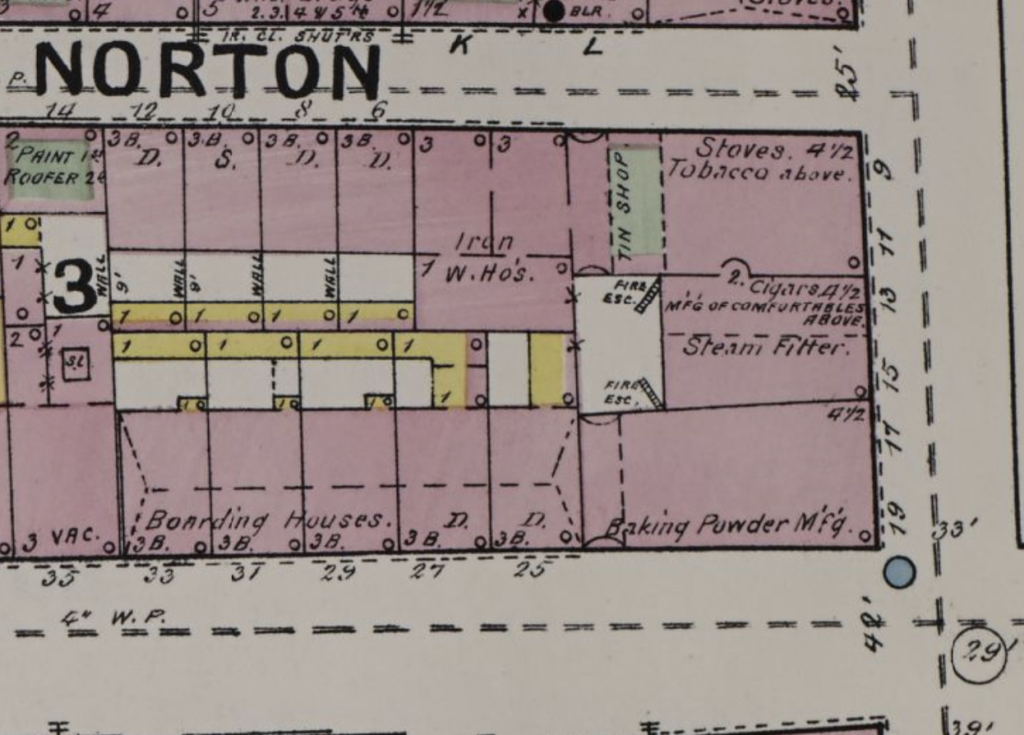
A 1910 article in The Argus just says that the marker was “on the Beaver Street wall of the building at the northwest corner of Beaver and Green streets . . . .” That would place it somewhere on the “Baking Powder M’f’g” building shown above, though what was there in 1886 when the marker was installed, we haven’t learned. (Neither Albany Baking Powder Company nor Thepure show up in the 1886 directory.)
In the 1915 city directory, 9 Green Street is listed as Borden’s Condensed Milk Co.; 13 is the Albany Oil Cloth Company and the Blatner Bros. & Co. bedding firm (probably the “Mfg. of Comfortables Above”), and 15 was Richard J. Boyle, gas fitter (the “Steam Fitter” on the map above). No. 17 contained what we have to believe was a combined operation of The Albany Baking Powder Company, Johnstown Gelatine Co., and Thepure Baking Powder Company, which we’ve written about before. (Whether those companies were one, or just shared space, is not made clear.) The Rudolph Wurlitzer musical instrument company was sandwiched in there somewhere. These would all be replaced by a new building, The Capitol Hotel.
The Capitol Hotel
That corner of Beaver and Green is the only one currently occupied, but it is held down by a modern skyscraper that passes over Norton and fronts on State Street. Prior to that, it was the site of the Capitol Hotel, which opened in 1925 or 1926 and undertook an expansion in 1927, growing by 75 rooms to 200, adding a fifth floor and an extension on Beaver Street. It was noted in the Argus that the Capitol Hotel was on an historic spot, and the paper noted that “on the building before the remodelling began was a plaque,” which they then quoted — it was our Tablet No. 19. “The tablet which was erected during the bi-centennial in 1886 will be replaced on the building when the renovations are complete.”
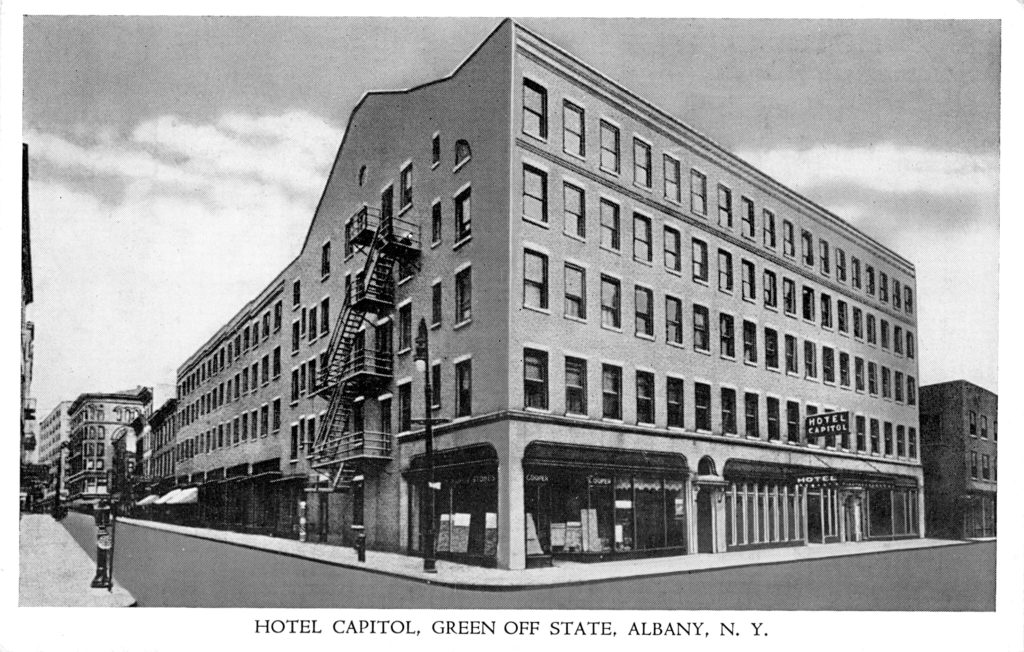
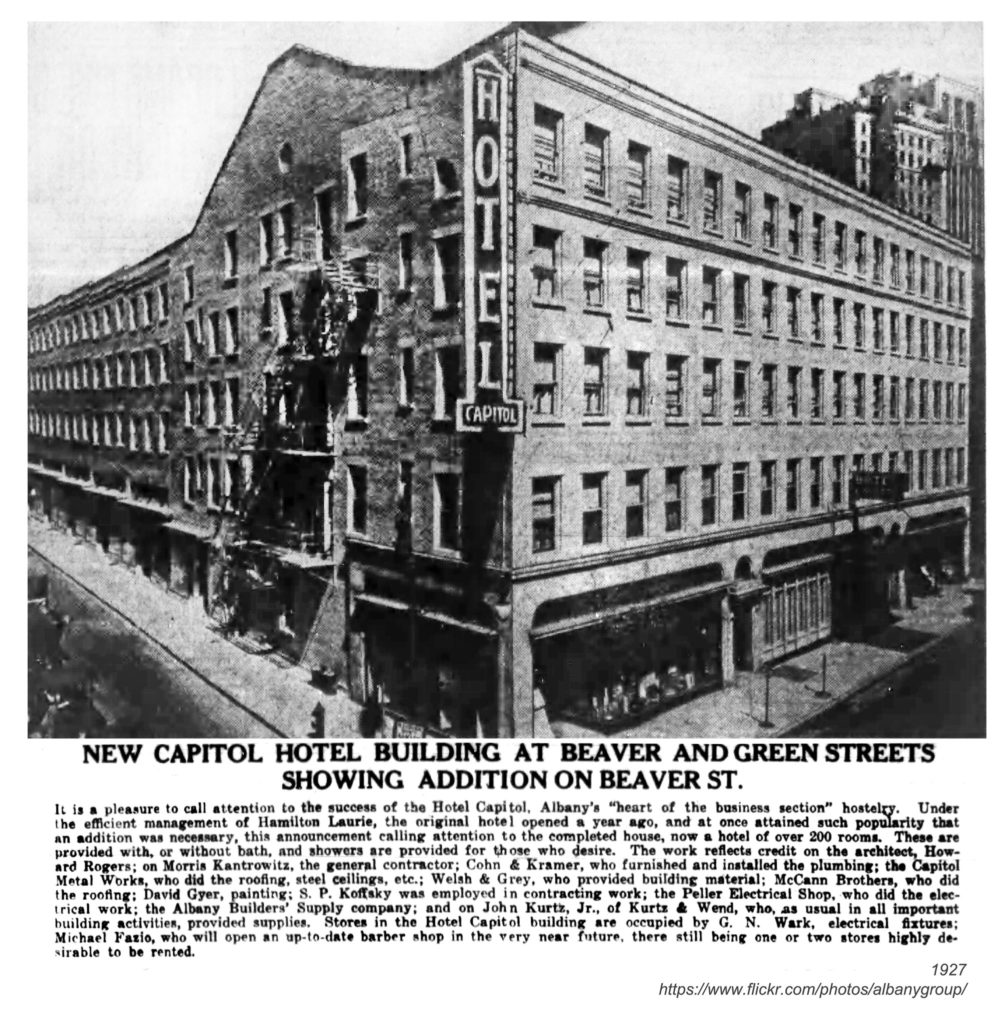
A 1938 article in the Times-Union indicates that the marker was actually placed inside the hotel. Under the “Rambling with DeWitt Schuyler” banner, a letter signed by a Peter Crumb mentions “Seems as how I’m sitting in the lobby of the Capitol Hotel,” and continues “Now there’s something I never noticed before, I thought to myself as I espied tacked to the wall an inconspicuous bronze plaque. I could make out the inscription from where I sat.” The inscription is that of Tablet No. 19. The rest of the story is a fantasy, and a rather heavy-handed one, about meeting General Washington in that space.
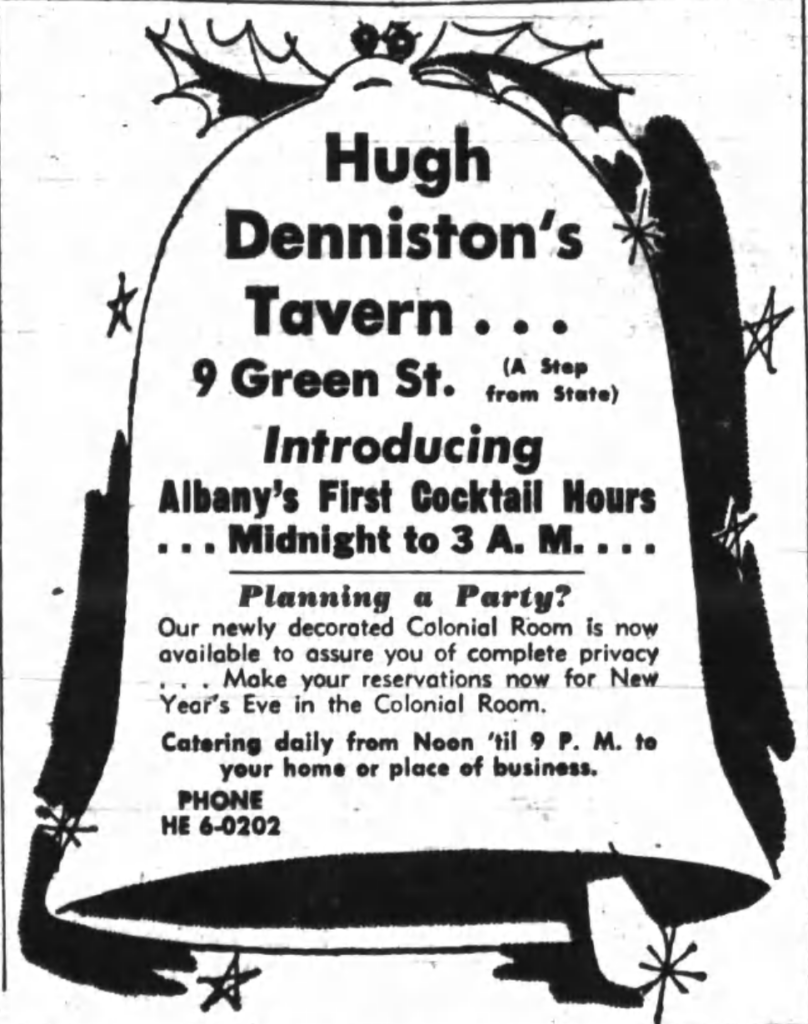
In 1961, the restaurant of the Capitol Hotel, with windows opening onto Green and Norton Streets, was remodeled into a “fashionable dining spot, with cocktail lounge, and the owners of the Capitol Hotel are negotiating for one of the best known maitre d’s in the east to make the carriage trade feel at home.” In a nod to history, they named it Hugh Denniston’s Tavern. Their draw to the carriage trade was a cocktail hour that ran from midnight to 3 am, 2 for 99 cent cocktail specials, and hours that ran from 7 AM to 1 AM. In announcing the opening of the new tavern, the historical marker was mentioned as still in the lobby of the Capitol Hotel.
The Capitol seems to have been more of a residential hotel than a transient, advertising rooms from $5 a week in 1942. It was still in business through at least September 1968, when the Knickerbocker news reported it would be closing. The owner, Ferdinand B. Levison, reported, “It’s become a terrible place in recent months . . . But come the first of the month and it’ll be closed. And I’ll be going to Florida.” By then it was appearing an address in police reports with some regularity.
The Capitol Hotel closed sometime in the last weeks of 1968. On December 31, it was reported in the Knickerbocker News that the National Commercial Bank & Trust Co. (you now know it as Key Bank) was purchasing the building for $300,000, and that the remaining commercial tenants, Hugh Denniston’s Tavern Restaurant and VB Printing, would have until May 1969 to vacate the premises.
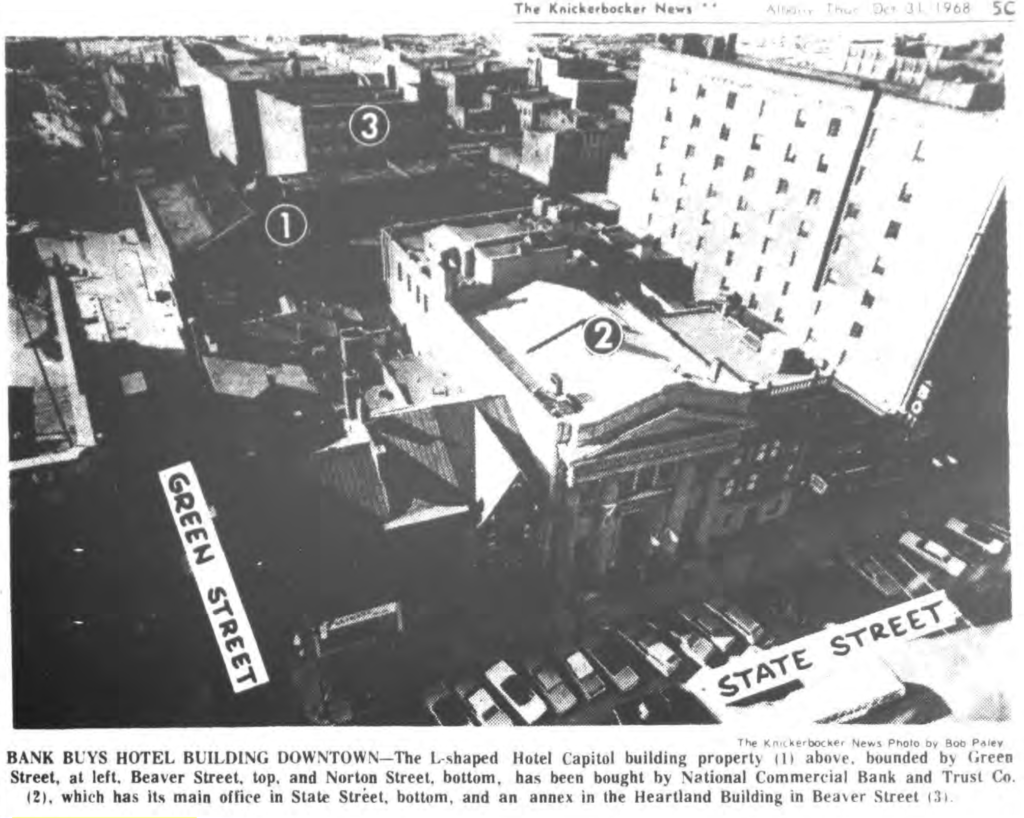
On March 2, 1969, the Times Union reported that the last three businesses in the Capitol Hotel (none of which were mentioned by the Knickerbocker News earlier) were moving out. They were Moe Engleman’s Sporting Goods, Cooper’s Sporting Goods, and Benny’s Tailor Shop, at 33, 31 and 29 Beaver Street, respectively. Cooper’s closed up shop, Benny Cacchillo moved his business to Ravena, and Engleman moved to 1088 Madison Avenue, near the Farmers and Mechanics Bank. “Reason for the stores’ leaving: The hotel building will be demolished soon to make way for a National Commercial Bank & Trust Co. parking lot.” There was no mention of the historical tablet at the time.
In 1971, National Commercial Bank and Trust Company (then headquartered in Albany) announced a plan to build a 10-story, $10 million dollar headquarters building on the site of the old Keeler’s (on State Street) and the Capitol Hotel, bridging over Norton Street. We have no doubt that in the demolition of the Capitol Hotel and the construction of the bank’s modern headquarters, the tablet was lost.


Leave a Reply